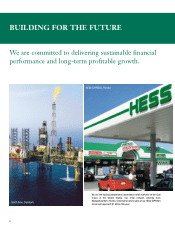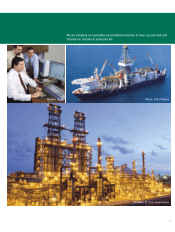Hess 2002 Annual Report Download - page 17
Download and view the complete annual report
Please find page 17 of the 2002 Hess annual report below. You can navigate through the pages in the report by either clicking on the pages listed below, or by using the keyword search tool below to find specific information within the annual report.
15
The Corporation presently estimates that its 2003 barrel of oil equiv-
alent production will be approximately 20% less than its 2002 pro-
duction. Approximately one-third of the expected decrease from
451,000 barrels of oil equivalent per day produced in 2002 is due to
potential asset sales and exchanges. The remainder reflects natural
decline from mature fields in the United States and United Kingdom
and reduced production from the Ceiba field in Equatorial Guinea.
Depreciation, depletion and amortization charges relating to explo-
ration and production activities increased by $350 million (before
income taxes) in 2002 and $246 million in 2001. The increases result
from higher unit costs, due to the amortization of the purchase price
of fields acquired in Equatorial Guinea, Colombia and the United
States, and increased production volumes. Production expenses also
increased in 2002 and 2001.The increase in 2002 was principally
due to increased production from fields with higher costs, including
workovers and other maintenance, and higher production volumes.
In 2001, the increase in production expense was largely due to
higher production volumes. Exploration expense decreased in 2002
compared with 2001, principally reflecting improved drilling results.
In 2001, exploration expense was higher than in 2000, due to
increased drilling and seismic purchases. General and administrative
expenses related to exploration and production activities decreased
in 2002, reflecting cost reduction initiatives. General and administra-
tive expenses were comparable in 2001 and 2000. The total cost per
barrel of oil equivalent produced (including depreciation, depletion
and amortization, production expense, exploration expense and
administrative costs) was $15.20 in 2002, $13.15 in 2001 and $11.60
in 2000. Total unit cost per barrel is expected to increase in 2003,
primarily due to the anticipated decrease in production.
During 2002, the United Kingdom government enacted a 10% sup-
plementary tax on profits from oil and gas production. A one-time
charge of $43 million was recorded as a special item to increase the
existing United Kingdom deferred tax liability on the balance sheet.
Excluding this deferred tax effect, the supplementary tax reduced
2002 earnings by approximately $37 million and is expected to
reduce future earnings by approximately $60 million annually (based
on 2002 production volumes and prices). Excluding the one-time
charge, the effective income tax rate on exploration and production
earnings was 41% in 2002, compared with 40% in 2001 and 41% in
2000. The effective income tax rate is expected to increase to
approximately 50% in 2003, reflecting a full year of the supplemen-
tary U.K. tax and a change in mix of producing fields. In 2001, explo-
ration and production earnings included $48 million of income from
the resolution of a United Kingdom income tax dispute. The effective
rates discussed above exclude the impact of this settlement.
The Corporation’s future exploration and production earnings may be
impacted by volatility in the selling prices of crude oil and natural gas,
reserve and production changes, tax increases, local political disrup-
tions and world events. The Corporation has hedged most of its 2003
production to mitigate volatility in selling prices.
Refining and Marketing: Operating earnings from refining and
marketing activities amounted to $40 million in 2002, $235 million
in 2001 and $288 million in 2000. The Corporation’s downstream
operations include HOVENSA L.L.C. (HOVENSA), a 50% owned refin-
ing joint venture with a subsidiary of Petroleos de Venezuela S.A.
(PDVSA), accounted for on the equity method. Additional refining and
marketing activities include a fluid catalytic cracking facility in
Port Reading, New Jersey, as well as retail gasoline stations, energy
marketing and trading operations.
HOVENSA: The Corporation’s share of HOVENSA’s 2002 loss was
$47 million compared with income of $58 million in 2001 and $121
million in 2000. The decrease in 2002 represents lower refining mar-
gins and reduced crude runs resulting from political disturbances in
Venezuela, HOVENSA’s principal source of crude oil. In connection
with the startup of new coking facilities in 2002, HOVENSA reduced
its inventory of high sulfur crude oil. Consequently, LIFO inventory
cost, which was lower than current cost, was included in 2002 cost
of sales. This reduced the Corporation’s share of HOVENSA’s loss by
approximately $15 million. The decrease in HOVENSA’s 2001 earn-
ings compared with 2000 was primarily due to turnarounds at the
fluid catalytic cracking unit and a crude unit which resulted in lower
charge rates and increased operating expenses. Income taxes
(benefits) on the Corporation’s share of HOVENSA’s results are not
recorded due to available loss carryforwards.
The Corporation’s share of HOVENSA’s crude runs amounted to
181,000 barrels per day in 2002, 202,000 in 2001 and 211,000 in
2000. The coker at HOVENSA is currently running at the rate of
approximately 58,000 barrels per day.
Operating earnings from refining and marketing activities also include
interest income on the note received from PDVSA at the formation of
the joint venture. Interest on the PDVSA note amounted to $35 million
in 2002, $39 million in 2001 and $48 million in 2000. Interest is
reflected in non-operating income in the income statement.
























